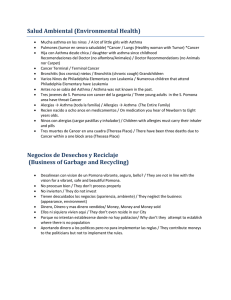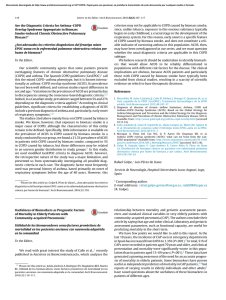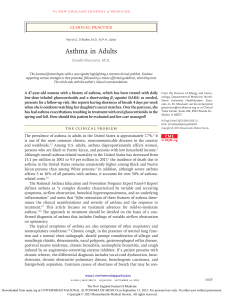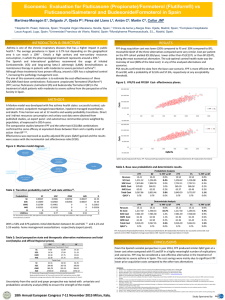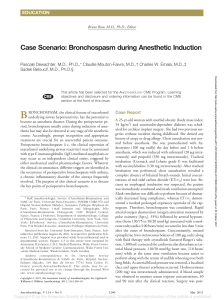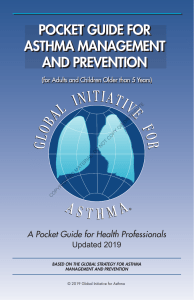Impact of Preventive Treatment With Long-Acting β2
Anuncio
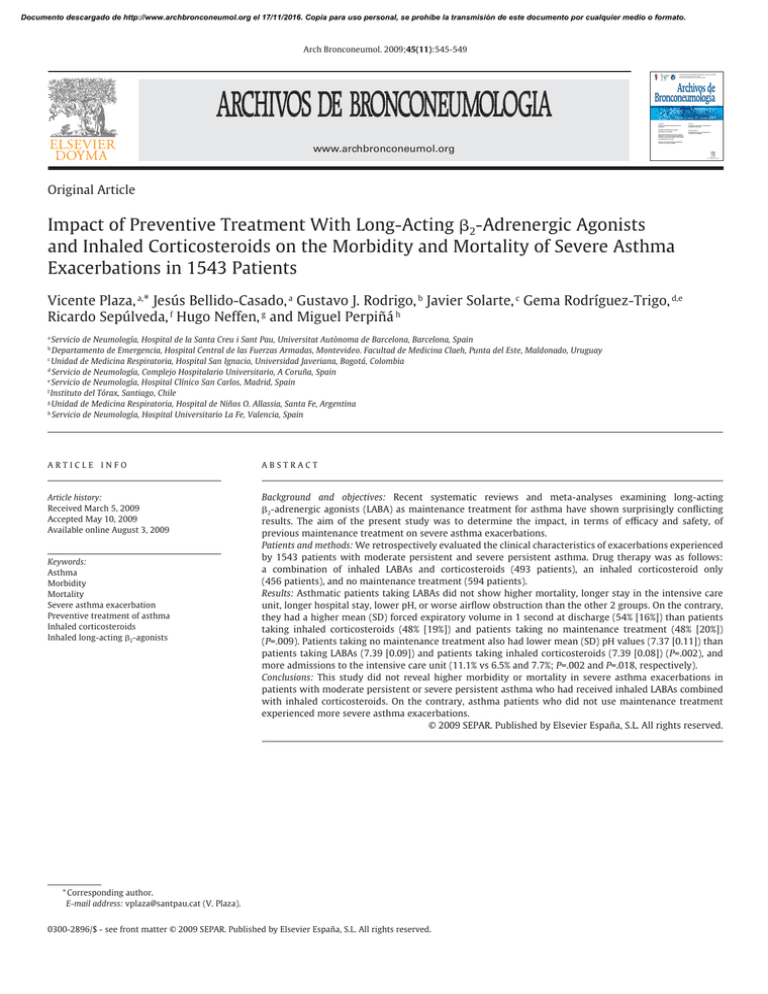
Documento descargado de http://www.archbronconeumol.org el 17/11/2016. Copia para uso personal, se prohíbe la transmisión de este documento por cualquier medio o formato. Arch Bronconeumol. 2009;45(11):545-549 Órgano Oficial de la Sociedad Española de Neumología y Cirugía Torácica (SEPAR), la Asociación Latinoamericana del Tórax (ALAT) y la Asociación Iberoamericana de Cirugía Torácica (AIACT) Archivos de Bronconeumología ISSN: 0300-2896 Volumen 45, Número 11, Noviembre 2009 Originales Revisión Cuidados respiratorios intermedios: un año de experiencia Prescripción de ejercicio en el tratamiento de deshabituación del tabaco Resultados asistenciales de una unidad especializada en tabaquismo Impacto del tratamiento preventivo con agonistas adrenérgicos �2 de acción larga y glucocorticoides inhalados en la morbimortalidad de 1.543 episodios de exacerbación grave de asma Artículo especial Año SEPAR 2007. Año para la Prevención y el Tratamiento del Tabaquismo Incidencia y características de las agudizaciones asmáticas en Barcelona (ASMAB II) www.archbronconeumol.org www.archbronconeumol.org Original Article Impact of Preventive Treatment With Long-Acting β2-Adrenergic Agonists and Inhaled Corticosteroids on the Morbidity and Mortality of Severe Asthma Exacerbations in 1543 Patients Vicente Plaza, a,* Jesús Bellido-Casado, a Gustavo J. Rodrigo, b Javier Solarte, c Gema Rodríguez-Trigo, d,e Ricardo Sepúlveda, f Hugo Neffen, g and Miguel Perpiñá h Servicio de Neumología, Hospital de la Santa Creu i Sant Pau, Universitat Autònoma de Barcelona, Barcelona, Spain Departamento de Emergencia, Hospital Central de las Fuerzas Armadas, Montevideo. Facultad de Medicina Claeh, Punta del Este, Maldonado, Uruguay c Unidad de Medicina Respiratoria, Hospital San Ignacio, Universidad Javeriana, Bogotá, Colombia d Servicio de Neumología, Complejo Hospitalario Universitario, A Coruña, Spain e Servicio de Neumología, Hospital Clínico San Carlos, Madrid, Spain f Instituto del Tórax, Santiago, Chile g Unidad de Medicina Respiratoria, Hospital de Niños O. Allassia, Santa Fe, Argentina h Servicio de Neumología, Hospital Universitario La Fe, Valencia, Spain a b ARTICLE INFO ABSTRACT Article history: Received March 5, 2009 Accepted May 10, 2009 Available online August 3, 2009 Background and objectives: Recent systematic reviews and meta-analyses examining long-acting β2-adrenergic agonists (LABA) as maintenance treatment for asthma have shown surprisingly conflicting results. The aim of the present study was to determine the impact, in terms of efficacy and safety, of previous maintenance treatment on severe asthma exacerbations. Patients and methods: We retrospectively evaluated the clinical characteristics of exacerbations experienced by 1543 patients with moderate persistent and severe persistent asthma. Drug therapy was as follows: a combination of inhaled LABAs and corticosteroids (493 patients), an inhaled corticosteroid only (456 patients), and no maintenance treatment (594 patients). Results: Asthmatic patients taking LABAs did not show higher mortality, longer stay in the intensive care unit, longer hospital stay, lower pH, or worse airflow obstruction than the other 2 groups. On the contrary, they had a higher mean (SD) forced expiratory volume in 1 second at discharge (54% [16%]) than patients taking inhaled corticosteroids (48% [19%]) and patients taking no maintenance treatment (48% [20%]) (P=.009). Patients taking no maintenance treatment also had lower mean (SD) pH values (7.37 [0.11]) than patients taking LABAs (7.39 [0.09]) and patients taking inhaled corticosteroids (7.39 [0.08]) (P=.002), and more admissions to the intensive care unit (11.1% vs 6.5% and 7.7%; P=.002 and P=.018, respectively). Conclusions: This study did not reveal higher morbidity or mortality in severe asthma exacerbations in patients with moderate persistent or severe persistent asthma who had received inhaled LABAs combined with inhaled corticosteroids. On the contrary, asthma patients who did not use maintenance treatment experienced more severe asthma exacerbations. © 2009 SEPAR. Published by Elsevier España, S.L. All rights reserved. Keywords: Asthma Morbidity Mortality Severe asthma exacerbation Preventive treatment of asthma Inhaled corticosteroids Inhaled long-acting β2-agonists * Corresponding author. E-mail address: [email protected] (V. Plaza). 0300-2896/$ - see front matter © 2009 SEPAR. Published by Elsevier España, S.L. All rights reserved. Documento descargado de http://www.archbronconeumol.org el 17/11/2016. Copia para uso personal, se prohíbe la transmisión de este documento por cualquier medio o formato. 546 Palabras clave: Asma Morbilidad Mortalidad Exacerbación grave de asma Tratamiento preventivo del asma Glucocorticoides inhalados Agonistas adrenérgicos β2 de acción larga inhalados V. Plaza et al / Arch Bronconeumol. 2009;45(11):545-549 Impacto del tratamiento preventivo con agonistas adrenérgicos �2 de acción larga y glucocorticoides inhalados en la morbimortalidad de 1.543 episodios de exacerbación grave de asma RESUMEN Introducción: Recientes revisiones sistemáticas y metaanálisis que han analizado la seguridad de los agonistas adrenérgicos β2 de acción larga por vía inhalada en el tratamiento de mantenimiento del asma han mostrado, sorprendentemente, resultados dispares. El objetivo de este estudio ha sido analizar el impacto, en términos de eficacia y seguridad, del tratamiento previo de mantenimiento del asma en la exacerbación asmática grave. Pacientes y métodos: Se han evaluado retrospectivamente las características clínicas de las exacerbaciones graves que presentaron 1.543 pacientes con asma persistente moderada o grave, de los que 493 recibían previamente un agonista adrenérgico β2 de acción larga más un glucocorticoide, ambos inhalados; 456 recibían sólo un glucocorticoide inhalado, y 594 no seguían ningún tratamiento de mantenimiento. Resultados: El grupo que recibía un agonista adrenérgico β2 de acción larga inhalado no presentó mayores mortalidad, necesidad de ingreso en la unidad de cuidados intensivos y estancia hospitalaria, peor pH ni mayor obstrucción del flujo aéreo que los otros 2 grupos de pacientes. Por el contrario, al recibir el alta hospitalaria presentó un volumen espiratorio forzado en el primer segundo significativamente mejor (p = 0,009): media ± desviación estándar del 54 ± 16%, frente al 48±19 y el 48 ± 20% de los otros 2 grupos. En el grupo que no recibía tratamiento previo el pH fue significativamente peor (7,37 ± 0,11, frente a 7,39 ± 0,09 y 7,39 ± 0,08) y hubo una mayor proporción de pacientes que precisaron ingreso en la unidad de cuidados intensivos (el 11,1 frente al 6,5 y el 7,7%), en comparación con los otros 2 (p = 0,002 y p = 0,018, respectivamente). Conclusiones: El presente estudio no constató una mayor morbimortalidad de la exacerbación asmática grave en los pacientes con asma persistente moderada-grave que recibían previamente tratamiento con un agonista adrenérgico β2 de acción larga y un glucocorticoide inhalados. Por el contrario, quienes no seguían tratamiento de mantenimiento presentaron una exacerbación más grave. © 2009 SEPAR. Publicado por Elsevier España, S.L. Todos los derechos reservados. Introduction Recent clinical practice guidelines for asthma—both from abroad1-3 and from Spain4—continue to recommend adding a longacting β2-adrenergic agonist (LABA) as the first choice for maintenance treatment in adults whose persistent asthma is poorly controlled using inhaled corticosteroids. Some studies with large samples5 or meta-analyses6 have questioned this indication, as they found an uncommon yet significantly greater risk of death, need for admission to hospital, and severe exacerbation in patients taking these agents on a regular basis. However, recent systematic reviews7 and metaanalyses8 covering larger samples have not corroborated these negative effects. Such discrepancies revive the old controversy about the safety of β2-adrenergic agonists, specifically that of LABAs. This controversy has been developing for the last 40 years, after the incorporation of short-acting β2-adrenergic agonists in the asthma armamentarium.9 It has resurfaced periodically, with the 2 epidemics of asthma deaths in the 1970s and 1980s, both of which were attributed to high doses of fenoterol, a short-acting β2-adrenergic agonist.10,11 In any case, it seems more than likely that overuse of β2-adrenergic agonists— particularly when they are not combined with an inhaled corticosteroid—entails a greater risk of adverse events, some of which may even be fatal. Thus, some authors have recently pointed out that the controversy has not been adequately resolved and are calling for more information and new studies.12 This is particularly relevant today, given the widespread use of LABAs in maintenance treatment for persistent asthma, an approach that is supported by the leading clinical guidelines. Almost all trials assessing the safety of LABAs have done so prospectively in large cohorts of asthma patients treated with one of these agents. However, there is little information from studies designed in the opposite direction, that is, studies that start with the exacerbation and assess the possibility that LABAs could actually favor attacks and their corresponding morbidity. If the hypothesis that previous treatment with LABAs leads to these negative effects, then we would observe more intense exacerbations with higher mortality rates in patients who use them than in those who do not. Our objective was to analyze this hypothesis. To do so, we used the database of the Study of Severe Asthma in Latin America and Spain (EAGLE), which retrospectively evaluated the clinical characteristics of severe exacerbations in a large sample of patients from both regions. Patients and methods EAGLE is an international multicenter retrospective observational study sponsored by the Assembly on Asthma of the Spanish Society of Pulmonology and Thoracic Surgery (SEPAR) and by the Asthma Section of the Latin American Thoracic Society (ALAT). It aimed to analyze the clinical characteristics of asthmatic patients (aged 15 to 69 and of both genders) who had to be admitted to hospital due to a severe exacerbation in 1994, 1999, and 2004. These patients came from 19 secondary or tertiary hospitals, 10 of which were in Latin America—Argentina (Rosario and Buenos Aires), Brazil (São Paulo), Chile (Santiago de Chile), Colombia (Bogotá), Mexico (México City), Peru (Lima), Uruguay (2 centers in Montevideo), and Venezuela (Caracas)—and 9 in Spain—A Coruña, Barcelona, Córdoba, Madrid, Mataró, Oviedo, Sagunto, Tarrasa, and Valencia. The study included data from 3088 severe exacerbations, and the results—together with the design and methodology—have been published in part elsewhere.13 Briefly, a severe asthma exacerbation was defined (International Classification of Diseases, Ninth Revision, code 493.01, and Tenth Revision, codes J45 and J46) as an exacerbation that required admission to hospital for at least 48 hours. The medical histories of the study patients provided the following data: demographic data, data related to the characteristics of asthma before the attack (usual treatment, type of follow-up, supposed degree of adherence, and spirometry values), and data related to the exacerbation (length of hospital stay, length of stay in the intensive care unit, duration of orotracheal intubation and mechanical ventilation, need for orotracheal intubation and Documento descargado de http://www.archbronconeumol.org el 17/11/2016. Copia para uso personal, se prohíbe la transmisión de este documento por cualquier medio o formato. V. Plaza et al / Arch Bronconeumol. 2009;45(11):545-549 547 Patients with severe asthma exacerbations who had to be admitted to hospital n = 3038 Patients with sufficient data to establish the degree of severity of previous asthma n = 2593 Patients with insufficient data to establish the degree of severity of previous asthma n = 445 Patients with moderate persistent or severe persistent asthma included in the analysis n = 1153 Patients with intermittent or mild persistent asthma n = 1050 Patients who were receiving ICs and LABAs n = 493 Patients who were receiving ICs only n = 456 Patients who were not receiving treatment n = 594 Figure. Patients evaluated in the Study of Severe Asthma in Latin America and Spain (EAGLE) project due to a severe asthma exacerbation and reasons for excluding cases from the study analysis. IC indicates inhaled corticosteroids; LABA, long-acting β2-adrenergic agonist. mechanical ventilation, mortality, gas exchange, peak expiratory flow on admission, and spirometric flow at discharge). Data were entered into the database online by the investigator at each participating center using a custom-designed area on the SEPAR web page (www.separ.es). Data were processed confidentially in accordance with the Spanish Law for Protection of Personal Data. The study was approved by the respective ethics committees of the participating centers. The analysis in the present study was performed using data from the 1543 patients for whom disease severity before the exacerbation was classified objectively (according to data in their medical history) as moderate persistent or severe persistent (Figure), in accordance with the criteria of the Global Initiative for Asthma (GINA).1 Given the hypothesis established, the sample was divided into 3 groups according to usual maintenance treatment: a) a LABA and an inhaled corticosteroid separately or in a single device (n = 493); b) inhaled corticosteroid only (n = 456); and c) no preventive therapy (n = 594). Statistical analysis Descriptive statistics were compiled for the 3 groups. Data were expressed as mean (SD) or percentages. Differences in means were compared between the groups using an analysis of variance for normally distributed independent samples, or using the nonparametric test for non-normally distributed variables. The Scheffé method was used to estimate significant differences when multiple comparisons were made between groups for the continuous variables, and the χ2 test for categorical variables. Statistical significance was set at a P value less than.05. The statistical software package SPSS version 12.0 for Windows (SPSS, Inc, Chicago Illinois, USA) was used to analyze the data. Results Fifty-two percent (n = 803) of the 1 543 severe exacerbations were recorded in Latin-American hospitals. The Table shows the distribution of patients with severe exacerbation according to geographic area and the maintenance treatment they had been taking before the exacerbation. The Spanish centers included a significantly greater proportion of patients taking a LABA combined with an inhaled corticosteroid; conversely, Latin American centers included a significantly greater proportion of patients who had not taken preventive therapy. In the group of patients who had taken previous therapy with a LABA, 43% (n = 212) did so with an inhaled corticosteroid in a single inhaler; 65% (n = 320) took salmeterol, and 35% (n = 173) took formoterol. As for the inhaled corticosteroid used in the 2 groups that had received previous treatment, 41% (n = 389) took budesonide, 30% (n = 285) took beclomethasone, and 29% (n = 275) took fluticasone. Demographic data and the clinical and therapeutic characteristics of asthma before the exacerbation are shown in the Table. The group that did not take previous maintenance therapy showed significant differences with the other 2 groups in terms of age (younger), number of women (lower), adherence (poorer), regular medical follow-up (less), and previous admissions due to asthma (fewer). A comparison of the 2 groups that had taken previous treatment (a LABA combined with an inhaled corticosteroid compared with an inhaled corticosteroid only) revealed no notable differences, not even in terms of the mean dose of inhaled corticosteroid (951 μg/d vs 991 μg/d, respectively). Data on clinical characteristics, mortality, length of stay, gas exchange, and lung function collected during the severe exacerbation are shown in the Table. The group that had previously taken a LABA combined with an inhaled corticosteroid did not present higher mortality, cardiorespiratory arrest, length of stay, poorer pH, or worse airway obstruction than the other 2 groups. It is noteworthy that, although all 3 groups had a similar degree of airflow obstruction (determined using peak expiratory flow) on admission, those who had received a LABA combined with an inhaled corticosteroid before the exacerbation presented a significantly smaller obstruction (determined using spirometry) at discharge than those who had taken only the inhaled corticosteroid. Even length of stay in the ICU (where necessary) for the group that had been treated with combination therapy was lower—and almost statistically significant (P = .077)—than in the other 2 groups. Patients who had not taken previous preventive treatment experienced a more severe exacerbation of their asthma than those who had—their pH values were significantly poorer and they were admitted to the ICU more often. Documento descargado de http://www.archbronconeumol.org el 17/11/2016. Copia para uso personal, se prohíbe la transmisión de este documento por cualquier medio o formato. 548 V. Plaza et al / Arch Bronconeumol. 2009;45(11):545-549 Table Demographic, clinical, and therapy-related characteristics of asthma before and during the exacerbation in 1 543 patients who had experienced a severe exacerbation. Patients are grouped according to the maintenance treatment they were receiving before the exacerbation a Origin and demographic data Cases from Latin America Cases from Spain Mean age, y (1347) Women (1543) Clinical data on asthma before the exacerbation Mean dose of IC per day, μg (650) Presumed good adherence to therapy (1236) Regular medical follow-up (1371) Previous admissions (1458) Best previous FEV1 (857) Worst previous FEV1 (704) Characteristics of the severe exacerbation Worst arterial pH (1158) PEF (491) Length of stay, d (1533) Admissions to the ICU (1543) Length of ICU stay, h (133) Duration of intubation/MV, h (77) Cardiorespiratory arrest (1541) Women (1543) Best previous FEV1 on discharge (438) LABA + IC (n = 493) IC (n = 456) No treatment (n = 594) P 70 (9%) 423 (57%) 48 (15) 75.7% 261 (32%) 195 (26%) 47 (15) 77% 472 (59%) 122 (17%) 44 (15) 65.2% 0.001b 0.001b,c 0.001b,c 0.001b 951 (397) 85.3% 89.2% 80.6% 75 (22%) 58 (17%) 991 (475) 85.6% 86.2% 83.4% 72 (23%) 52 (20%) 0 58.4% 45.8% 68.9% 73 (24) 55 (22%) 0.242 0.001b 0.001b 0.001b 0.450 0.009c 7.39 (0.09) 41 (14%) 7 (1-45) 6.5% 24 (2-968) 24 (1-968) 3% 1.4% 54 (16%) 7.39 (0.08) 42 (16%) 7 (1-96) 7.7% 48 (4-288) 24 (1-192) 2.6% 1.3% 48 (19%) 7.37 (0.11) 42 (18%) 7 (2-68) 11.1% 48 (1-432) 46 (1-456) 4.6% 1.2% 48 (20%) 0.002b 0.939 0.354 0.018b 0.077 0.370 0.197 0.940 0.009c Abbreviations: FEV1, forced expiratory volume in 1 second; IC, inhaled corticosteroids; ICU, intensive care unit; LABA, long-acting β2-adrenergic agonist; MV, mechanical ventilation; PEF, peak expiratory flow. a Values are expressed as percentage of cases, mean (SD), or median (minimum-maximum). The numbers in parenthesis in the first column on the left (variables) represent the number of patients available for the analysis of each of the variables. b P <.05 when the group not taking preventive treatment group was compared with the other 2. c P <.05 when the group taking IC was compared with the group taking LABA combined with IC. Discussion After analyzing a large sample of patients with moderate to severe persistent asthma, we can say that the main contribution of this study is the observation that those who took a LABA combined with an inhaled corticosteroid in their maintenance therapy did not show greater morbidity and mortality in severe exacerbations. Therefore, as far as the controversy surrounding the safety of inhaled LABAs is concerned, these results contrast with those of the first studies that reported increased mortality in asthmatics who were taking them as their habitual preventive therapy.5,6 However, the same results would be consistent not only with studies that have not observed this effect,7,8 but also with the general perception of physicians14 that, despite widespread use of these drugs since they became available more than 15 years ago, no greater mortality has been observed in asthma patients. If we apply the calculations from the meta-analysis by Salpeter et al,6 who estimated approximately 4000 annual deaths per 3.5 million individuals treated with salmeterol in the USA, at least 400 people would die of this cause every year in Spain.15 If this were the case, such a figure would not have gone unnoticed. Not only has this not been observed,16-18 but, as is the case in other geographic areas, the asthma mortality rate has decreased significantly during the same period.19,20 Another interesting result, consistent with the above, is the observation that patients taking inhaled LABAs recovered more quickly from their exacerbation, namely, a significantly less severe airflow obstruction at discharge and a clear trend (almost statistically significant) towards a shorter stay in the ICU in the most severe exacerbations. Some authors have suggested that habitual use of inhaled LABAs could lead to reduced bronchodilatory capacity of short-acting β2-adrenergic agonists during the exacerbation.21 Some studies have shown a reduced bronchodilatory effect for salbutamol22 and terbutaline23 after the methacholine challenge test in patients who had been treated with a LABA. Nevertheless, this loss in bronchodilatory capacity does not seem to be confirmed in clinical practice,24 even in very severe exacerbations such as those assessed in the present study. Along these lines, Matz et al25 observed greater and more rapid bronchodilation in patients with asthma exacerbations who were taking salmeterol and fluticasone (176 μg/d) than in patients who were taking fluticasone only at higher doses (440 μg/d). This difference was more significant from the third day of treatment after the exacerbation. Of particular interest are the characteristics of the group of patients who received no maintenance treatment, despite presenting moderate persistent and even severe persistent asthma. Most of these patients (79.5%) were from the Latin American centers. The total proportion of Spanish patients who were not taking inhaled corticosteroids (16.4%) was considerably lower than that of the Latin American patients (58.7%). Such a difference undoubtedly reflects the socioeconomic differences between both areas. The demographic characteristics of patients from the Spanish centers do not differ substantially from those recently reported by Morell et al,26 who evaluated 831 exacerbation episodes in Barcelona. The most notable characteristics of the group not taking preventive treatment are lower age, greater proportion of men, and the almost total neglect with which these patients managed their illness, with significantly lower proportions of patients with adequate adherence and regular medical follow-up. These circumstances are well documented and are associated with lower adherence.1 However, the most interesting result in patients who had not previously received inhaled corticosteroids is that their exacerbation was more intense or severe (poorer pH level and higher number of admissions to the ICU) than that of the patients from the other 2 groups. Therefore, we might conjecture that, by mitigating the chronic bronchial inflammation characteristic of the disease, previous treatment with inhaled corticosteroids could, to a certain extent, attenuate the acute inflammation accompanying the exacerbation and lead to less intense exacerbations. Few studies have attempted to determine this extreme. Carroll et al27 retrospectively evaluated 241 severe asthma exacerbations in children admitted to the ICU—44% were receiving previous treatment with inhaled corticosteroids, although no differences were observed in the intensity of the attack or in length of stay according to previous treatment received. Documento descargado de http://www.archbronconeumol.org el 17/11/2016. Copia para uso personal, se prohíbe la transmisión de este documento por cualquier medio o formato. V. Plaza et al / Arch Bronconeumol. 2009;45(11):545-549 Although the retrospective nature of the present study could cast doubt on the quality of its conclusions, we believe that the large study sample makes possible a sufficiently robust exploration of the hypothesis proposed—the impact of a previous LABA on the morbidity and mortality of severe asthma exacerbations. The observational nature of the study is one of its greatest strengths: it was possible to include a group of patients whose condition was as severe before the exacerbation but who did not take maintenance treatment. Such a circumstance would have been unacceptable in a prospective randomized study. In short, the present study, which was designed from a clinical perspective, did not reveal greater morbidity or mortality of severe asthma exacerbations requiring admission to hospital in patients who were taking continuous treatment with LABA and inhaled corticosteroids. The conclusions of this study could provide arguments in favor of the opinion that, when LABA are administered in combination with inhaled corticosteroids, there is no increased risk, in terms of safety, or poorer therapeutic response to the action of short-acting bronchodilators, in terms of efficacy, during the exacerbation. References 1. Global Initiative for Asthma. Global Strategy for Asthma Management and Prevention NHLBI/WHO Workshop Report. 2006. Available from: http://www. ginasthma.com 2. British Thoracic Society, Scottish Intercollegiate Guidelines Network. British guideline on the management of asthma. 2007. Available from: http://www.sign. ac.uk/guidelines 3. National Asthma Education and Prevention Program. Expert Panel Report 3: Guidelines for the diagnosis and management of asthma. Bethesda: National Institutes of Health, National Heart, Lung, and Blood Institute; 2007. 4. Guía Española para el Manejo del Asma (GEMA). Available from: http://www. gemasma.com 5. Nelson HS, Weiss ST, Bleecker ER, Yancey SW, Dorinsky PM; SMART Study Group. The Salmeterol Multicenter Asthma Research Trial: a comparison of usual pharmacotherapy for asthma or usual pharmacotherapy plus salmeterol. Chest. 2006;129:15-26. 6. Salpeter SR, Buckley NS, Ormiston TM, Salpeter EE. Meta-analysis: effect of longacting beta-agonists on severe asthma exacerbations and asthma-related deaths. Ann Intern Med. 2006;144:904-12. 7. Sears MR, Ottosson A, Radner F, Suissa S. Long-acting ‚-agonists: a review of formoterol safety data from asthma clinical trials. Eur Respir J. 2009;33:21-32. 8. Rodrigo GJ, Plaza Moral V, García-Marcos L, Castro-Rodríguez JA. Safety of regular use of long-acting beta agonists as monotherapy or added to inhaled corticosteroids in asthma: a systematic review with meta-analysis. Pulm Pharmacol Ther. 2009;22:9-19. 549 9. Speizer FE, Doll R, Heaf P, Strang LB. Investigation into use of drugs preceding death from asthma. Br Med J. 1968;10:339-43. 10. Crane J, Pearce N, Flatt A, Burgess C, Jackson R, Kwong T, et al. Prescribed fenoterol and death from asthma in New Zealand, 1981-83: case-control study. Lancet. 1989;29:917-22. 11. Pearce N, Grainger J, Atkinson M, Crane J, Burgess C, Culling C, et al. Case-control study of prescribed fenoterol and death from asthma in New Zealand, 1977-81. Thorax. 1990;45:170-5. 12. Beasley R, Martínez FD, Hackshaw A, Rabe KF, Sterk PJ, Djukanovic R. Safety of long-acting β-agonists: urgent need to clear the air remains. Eur Respir J. 2009; 33:3-5. 13. Rodrigo GJ, Plaza V, Bardagí S, Perpiñá M, Salas J. Factors associated with mortality in patients hospitalized for severe acute asthma over a ten year period (19942004) in Spain and Latin-america. J Bras Pneumol. 2008;34:546-51. 14. Ernst P, McIvor A, Ducharme FM, Boulet LP, FitzGerald M, Chapman KR, et al; Canadian Asthma Guideline Group. Safety and effectiveness of long-acting inhaled beta-agonist bronchodilators when taken with inhaled corticosteroids. Ann Intern Med. 2006;145:692-4. 15. Domingo Ribas C. Mortalidad por betaagonistas o el riesgo de la inferencia. Arch Bronconeumol. 2007;43:355-7. 26. Bellido Casado J, Plaza V, Bardagí S, Cosano J, López Viña A, Martínez Moragón E, et al. ¿Disminuye la incidencia de asma de riesgo vital en España? Arch Bronconeumol. 2006;42:522-5. 17. López-Campos JL, Cayuela A, Rodríguez-Domínguez S, Vigil E. Temporal trends in asthma mortality over 30 years. J Asthma. 2008;45:611-4. 18. Rodríguez-Trigo G, Plaza V, Picado C, Sanchis J. El tratamiento según la guía de la Global Initiative for Asthma (GINA) reduce la morbimortalidad de los pacientes con asma de riesgo vital. Arch Bronconeumol. 2008;44:192-6. 19. Haahtela T, Klaukka T, Koskela K, Erhola M, Laitinen LA. Working Group of the Asthma Programme in Finland 1994-2004. Asthma programme in Finland: a community problem needs community solutions. Thorax. 2001;56:806-14. 20. Sly RM. Decreases in asthma mortality in the United States. Ann Allergy Asthma Immumnol. 2000;85:121-7. 21. Orriols R, Vallano A. Riesgo de los broncodilatadores agonistas β2-adrenérgicos de acción prolongada en el asma bronquial. Med Clin (Barc). 2007;128:352-4. 22. Van der Woude HJ, Winter TH, Aalbers R. Decreased bronchodilating effect of salbutamol in relieving methacholine induced moderate to severe bronchoconstriction during high dose treatment with long acting b2 agonists. Thorax. 2001;56:529-35. 23. Lee DKC, Jackson CM, Bates CE, Lipworth BJ. ß2 adrenoceptor genotype-16 in asthmatic cross tolerance to salbutamol occurs independently patients receiving regular formoterol or salmeterol. Thorax. 2004;59;662-7. 24. Nelson HS. Is there a problem with inhaled long-acting b-adrenergic agonists? J Allergy Clin Immunol. 2006;117:3-16. 25. Matz J, Emmett A, Rickard K, Kalberg C. Addition of salmeterol to low-dose fluticasone versus higher-dose fluticasone: an analysis of asthma exacerbations. J Allergy Clin Immunol. 2001;107:783-9. 26. Morell F, Genover T, Muñoz X, García-Aymerich J, Ferrer J, Cruz MJ. Rate and characteristics of asthma exacerbations: the ASMAB I Study. Arch Bronconeumol. 2008;44:303-11. 27. Carroll CL, Bhandari A, Schramm CM, Zucker AR. Chronic inhaled corticosteroids do not affect the course of acute severe asthma exacerbations in children. Pediatr Pulmonol. 2006;41:1213-7.

